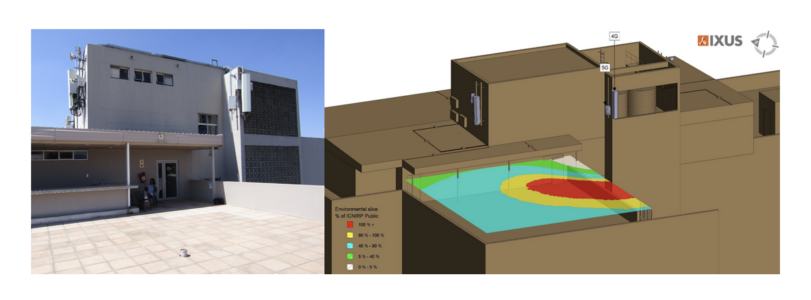As large-scale network operators roll out 5G, network planners are deploying base station sites closer and closer together, as well as closer to the public at large. Alphawave, a specialized technology investment group, previously known as EM Software and Systems (EMSS), recently held a webinar, “EMF-aware Planning of 5G Network Rollouts,” which discussed the misinformation spread around about the health effects of 5G and how the telecom industry can easily design base station sites with safe levels of electromagnetic field radiation (EMF).
“Ensuring a base station is (RF) compliant involves identifying non-compliant regions or zones and implementing reasonable engineering or administrative control measures for identified non-compliance zones,” Nel said.
The features of 5G that have a major impact on RF compliance include beamforming, densification and the use of millimeter waves. IXUS has a database of numerous antennas in the millimeter wave band. Densification doesn’t necessarily cause a problem, because the coverage areas can accurately be simulated showing how close the public can safely come to an antenna, according to Nel. Although beamforming may cause “significant problems” for RF compliance, he said, a simulation-driven approach enables your engineering teams to quickly assess the risks involved. This software rapidly analyzes preliminary designs, thereby decreasing the overall risk preceding the construction phase.
“The IXUS antenna service ensures the results are of the highest possible quality,” Nel said. “We have an excellent, actually pedantic, team of antenna engineers. Every model is reviewed and verified by more than one person before published, following a formal, traceable process.”
Network planners should gather information early on in the planning process, Nel said. With 5G technology, the EMF exposure limitations are an additional concern as a result of the dynamic, multi-beam nature of the antennas. Therefore, EMF-aware planning is becoming increasingly more important.
“What is the most important thing to remember when planning where to install your 5G antennas?” he asked. “We recommend that you don’t automatically assume that your base station will be compliant by installing beamforming antennas at the same height as 4G (non-beamforming) antennas, especially if the non-compliant zones were already close to the public.”
“When we consider a beamforming antenna, the lowest point of the non-compliant zone is much lower than the bottom of the radome. This is due to the vertical scanning and beam steering capabilities of 5G antenna models,” he said.
The IXUS team has played a fundamental role in the early stages of development of 5G regulations over the past few years, according to Nel. It has been working closely with industry, government bodies, associations and academia to ensure the wireless industry is ready for the challenges to come, he added.
To watch the replay of the webinar, visit here.




Reader Interactions